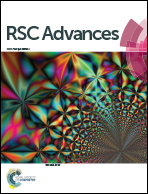Mixed-ligand copper(ii)-phenolate complexes: structure and studies on DNA/protein binding profiles, DNA cleavage, molecular docking and cytotoxicity†
Abstract
Copper(II) complexes with simple and mixed ligands, [Cu(L)(ClO4)] (1) and [Cu(L)(diimine)]ClO4 (2–4) [where L is 4-chloro-2-((2-(phenylthio)phenylimino)methyl)phenol and diimine is 1,10-phenanthroline (phen, 2), 2,2′-bipyridine (bpy, 3) or 4,4′-dimethyl-2,2′-bipyridyl (dmbpy, 4)], were synthesized and characterized by elemental analysis, UV-vis, FT-IR, electrospray ionization-mass spectrometry (ESI-MS) and electrochemical studies. Notably, complex 4 was structurally characterized using single X-ray crystallography. It was observed that this complex has a slightly distorted square planar geometry. The varying interactions of these complexes with herring sperm DNA (HS-DNA) were explored in detail using various spectral and electrochemical methods to gain insight into their structure–activity relationships. The obtained results revealed that complexes 1, 3 and 4 could interact with HS-DNA via a partial intercalation mode, whereas complex 2 was found to deeply stack between base pairs with a binding constant of 104 M−1 due to its enhanced planarity; moreover, 4 underwent a hydrophobic interaction with DNA. These experimental observations were found to be close to the theoretical observations investigated by the molecular docking technique. The interaction of these synthesized Cu(II) complexes with bovine serum albumin (BSA) was also evaluated using absorption and fluorescence techniques, which revealed a static quenching mechanism between the complexes and BSA. In addition, DNA cleavage by the complexes was monitored by electrophoretic spectrometry; the results showed that these complexes exhibited significant cleavage in the presence of a reducing agent (ascorbic acid). The in vitro cytotoxicity of these Cu(II) complexes was carried out in two different human tumour cell lines, A549 and Huh7. Furthermore, molecular docking was also used to evaluate and understand the interaction modes of the complexes with the molecular target DNA. All the in vitro pharmacological evaluation observations clearly indicated the superior DNA binding/cleaving and protein binding properties of these complexes, although the S-donor atom did not coordinate with the central copper ion in the mixed complexes.


 Please wait while we load your content...
Please wait while we load your content...